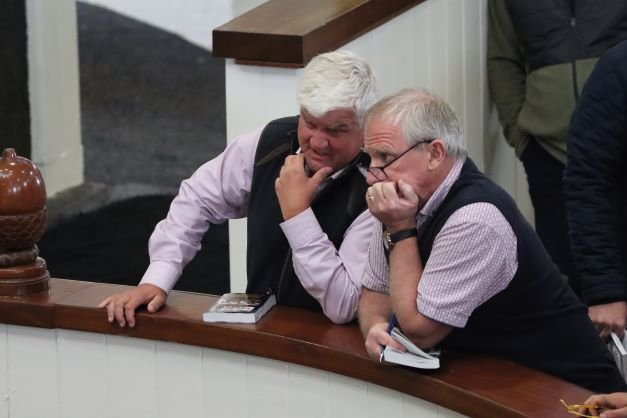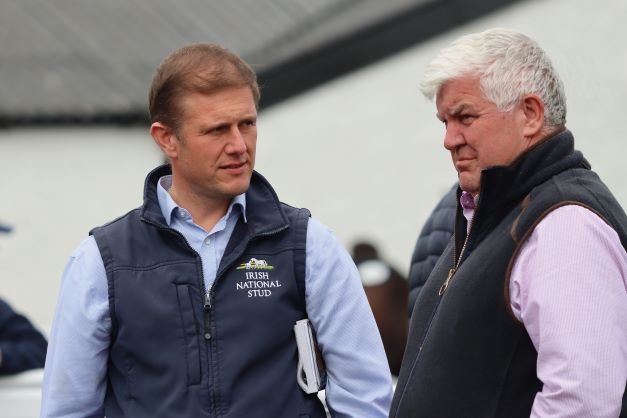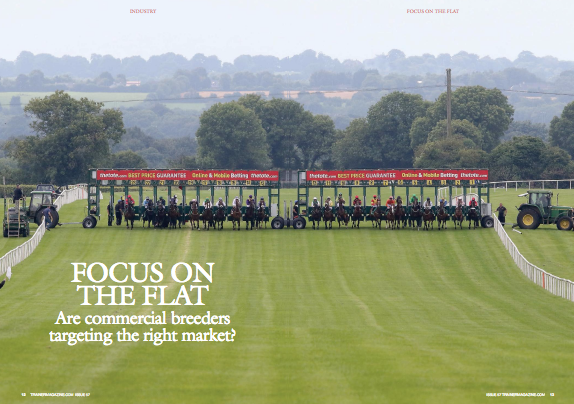How the Chehboub family has become a major player in the French breeding and racing industry
/Article by John Gilmore
Kamel Chehboub and Sealiway at the Haras de Beaumont
The Chehboub family have started an exciting new breeding development in Normandy, through purchasing the Haras de Beaumont stud. The deal also included a part of the adjacent Haras du Quesnay land, which is being sold by the Head family in two parts. The other part is being bought by Businessman Stephane Courbit. “We will know in a few months whether Haras du Quesnay will continue as a stud,” indicated Freddie Head. The stud, which was made famous by his father Alec Head, was originally bought by his grandfather William Head in 1958.
Buying Haras de Beaumont and part of the neighbouring Haras du Quesnay has certainly created the environment for Kamel Chehboub to develop his racing and breeding interests. His daughter Pauline Chehboub is responsible for day-to-day operations.
The Chehboub family have for the past eight years, owned the Haras de la Gousserie, in the Loire region of France. That farm is due to be sold, with all the mares and stallions being relocated to Haras de Beaumont. As a result, the Chehboub racehorses, which previously ran under the name of Haras de La Gousserie, will now be changed to ‘Ecurie de la Gousserie.’
Rougir
Overall, it’s been an eventful past couple of years for the Chehboub family. Their filly Rougir, winner of the Gp 1 Prix de L’Opera, went through the ring at the Arqana Breeding stock sale December 2021 as a 3-year-old for a record €3m, selling to Peter Brant’s White Birch farm and Coolmore partnership.
Rougir is now trained in the United States by Chad Brown and has since justified the high price tag, with a first time out three-length facile victory at Belmont when capturing the Gr3 Beaugay Stakes in May and stepping up in October to take the Gr1 EP Taylor Stakes at Woodbine Canada.
Rougir’s sale was certainly a jackpot pay day for Kamel Cheboub and his Haras de la Gousserie breeding and racing enterprise. Rougir was bought as a yearling for €55,000 at the Arqana yearling sale, after previously being sold as a foal through the same auctioneers for just €11,000.
Sealiway
The 2021 Champion Stakes winner Sealiway, which the Chehboub family owns in partnership with Guy Parente, will be a major attraction at Beaumont. His stud fee has been set at €12,000.
Additionally, another high-profile Gp1 winner Intello, who the Wertheimer brothers own and previously stood at the Haras du Quesnay, will be transferred next door to take up stud duties at Beaumont for an €8,000 euro.
“We thought it was an appropriate stud to place Intello, as Champion Stakes winner Sealiway will certainly be popular, which could also add interest from breeders to our 2013 Prix du Jockey Club winner, stabled in the same place,” said Pierre-Yves Bureau Breeding and Racing manager for the Wertheimer brothers.
Sealiway was originally a €62,000 yearling purchase at Arqana. Both Rougir and Sealiway’s performances on the racecourse have certainly put Haras de la Gousserie on the map. They have also expanded their racing presence through acquiring a new yard at Chantilly, in addition to their other main training yard in Marseille.
It’s a far cry from those early days more than 30 years ago for property businessman Kamel Chehboub, which first sparked his initial interest in racing. “My father first started going to the racetrack with friends who were punters and gradually began to enjoy the sport himself”, explained Pauline Chehboub.
“After a while, my father began to take shares in racehorses sourced from claiming races. The first was Onegar in 1987, bought out of Andre Fabre’s stable.” The big breakthrough came with the filly Lavayssiere, who was placed 5 times in 13 runs on the flat but proved a revelation at stud. Lavayssiere produced 5 Black Type horses from 8 runners, including her second foal Gp1 winner Spirit One, born in 2004.
“Spirit One and jockey Ioritz Mendizabel’s enterprising all the way win in the Gr1 Arlington Million race at Chicago in August 2008, trained by Philip Demcastel, was a tremendous boost to my father’s racing operations-enabling him to start developing the business and buy more racehorses.” The €403,504 pot of prize money for the Arlington Million victory, boosted Spirit One’s career earnings to €974,269, which included winning 5 races from 19 starts.
Spirit One entered the Haras de Lonray in the Herault southern region of France and later relocated to Sablonnets in the Sarthe department (western France) from 2013. The best of his 36 winning offspring was Eleuthera, who won the Gp3 Prix de Royaumont in 2013 and was subsequently purchased by Teruya Yoshida. Spirit One sadly died of a tumour at Haras des Sablonnets in April 2016.
Pauline Chehboub
Pauline Chehboub has been working for her father and Uncle Bouzid Chehboub’s racing interests for the past 7 years, after obtaining her commercial business licence. Previously in her youth she rode in show jumping events to a high level. “I was show jumping champion of France at 16 years old and have been riding since I was a child. So working within the horseracing industry was always something I wanted to do, especially as my father was very involved in the industry.”
She added, “My father has had more than 20 years’ experience in this business, through regularly going racing, visiting the sales, and observing the training. Over the past few years, he has taken the trouble to pass on this valuable knowledge to me, concerning key points of what to first look out for in a racehorse and their development through observation, physique and origin.”
Pauline Chehboub is now manager of the family racing and breeding operations, which operates two training yards in Chantilly and Marseille, plus stud activities. She is often seen at the racecourse and regularly on the early morning gallops in Chantilly.
“It’s a seven-day-a-week job, with 35 horses in training at Chantilly, and a further 20 at Calas-Cabriès training centre in Marseille. Apart from keeping tabs on the racehorses, there is also the stud. Not forgetting the administration side, which includes discussing the well-being of the racehorses, future race entries with the trainer, accounts work, buying yearlings, horses to sell and the breeding nominations.”
“In September 2021, we bought the yard in Chantilly on the Chemin des Aigles as we thought it was important to have a presence for all the main meetings in the Paris region, as well as in Marseille. In this way we can cut down on travelling, through having yards both in the North and South, with the better horses generally based in Chantilly.”
Marseille-based trainer Cedric Rossi trained for a number of different clients, including the Haras de la Gousserie up until December 2021. The subsequent revelation of alleged doping and stopping horses’ investigation by the police three days after Rougir went through the ring, concerning several people including Cedric Rossi, was a major shock for French racing.
“Cedric Rossi was our principal trainer at the time, and after the alleged doping investigations, we transferred our horses to other trainers, with many at the time going to Richard Chotard and Sealiway to Francis Graffard at Chantilly,” said Pauline Cheboub.
“We transferred Sealiway to Francis Graffard’s stables in Chantilly this season, because his record shows the trainer has a lot of talent. Sealiway has not really had conditions in his favour this season. His best races have been when coming off a fast pace and on soft ground conditions, as in the Champion Stakes.” After a disappointing run in this year’s Arc de Triomphe, Sealiway was subsequently retired to stud.
The Haras de la Gousserie racing and breeding business has worked in a certain tried and trusted way. The stud was bought eight years ago; after the Haras de Lonray, in the South of France Herault region, where the Chehboub breeding stock was previously lodged, went into financial difficulties. Finally they chose to purchase Haras de la Gousserie in the Loire region because it also offered pre-training facilities.
“We do not sell many of our breeding stock at the sale, as we breed to race. Each year we buy around 20 yearlings at the Arqana August and October sales, looking for French-bred horses with precocity and the possibility to win as two-year-olds, and not by yearlings with expensive leading stallion pedigrees.”
“The objective is to find some good horses each year to eventually add to our breeding stock. Those that turn out to be not future breeding prospects may end up in claiming races to be claimed, or sold through the in-training sales. We like to keep around 20 broodmares to breed from.”
Now they hope to continue to develop and progress, after transferring their entire breeding stock to their new stud venture in Normandy.
It is clear the Chehboub’s racing and breeding operations has been developing over the past decade, through its policy of buying more and better quality yearlings at the Arqana August and October sales, that has borne fruit as results on the track clearly show.
In 2013, just 19 racehorses won €573,853 in prize money and premiums; and last year, 41 racehorses earned €2,107,125—nearly 4 times as much.
They have now progressed to be one of the top ten racehorse owners in France, finishing 9th in 2021; and in early December, nearing the end of the 2022 season, they were once again in 9th position.
It would seem the Chehboub family name has now been firmly established, to become a major player in the French breeding and racing industry. Next year (2023) looks set to be another milestone year.
Haras de beaumont




















